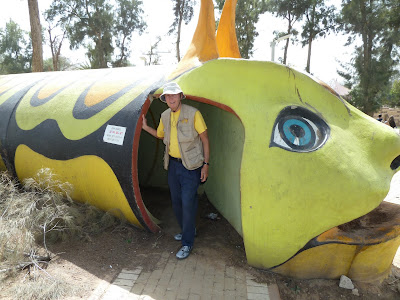 |
| Incoming Ecumenical Accompaniers at the handover cermony |
 |
| Outgoing (left) and incoming Jerusalem teams |

There is a demolition order to destroy this barn in Nabi Samwil built with French aid after authorities destroyed earlier tents three times.
Taxi driver Moyad Ghazawneh in Ar-Ram died from tear gas shot in his cab by Israeli soldiers, leaving a widow and two daughters, one born 10 days after his death.
At a demonstration at the Damascus Gate we saw the young man below arrested. Arrests of minors, mostly for stone throwing, is common. One woman said her 13-year-old brother was arrested 33 times in the last four years.
 |
| (Photo by EA Esteban Gutierrez) |
Thousands of Palestinians endure the daily aggravation of crossing Israeli checkpoints, like this one at Qalandiya, between Ramallah and Jerusalem. EAPPI monitors it from 4:30 to 7:30 a.m. three times a week, when on bad days it can take workers more than an hour to cross.
For four consecutive Friday mornings Muslim men under the age of 50 were denied access to the Old City for Friday prayers in Al-Aqsa mosque. Police told us it was because "there might be problems." One time there was a security cordon with checkpoints on approach streets and all around within the city.

In the Kaabneh Bedouin community near Jaba, children have to crawl through a drainage culvert to get to school under busy highways to Israeli settlements. But Bedouin children in Wadi Abu Hindi have a new kindergarten thanks to international organizations.
I will remember watching students cross the Zatoun checkpoint to get to their school in Jerusalem, and accompanying boys from a school in Wadi Rabada to avert problems with Israeli settlers or police.
In Israel close to the Gaza strip, children in Sderot unfortunately need shelters like this big worm to protect them from Palestinian rockets.
In the village of Kafr Qaddum near Tulkarm in the West Bank, boys roll out tires to burn for the weekly protest against the blockade of their road for the convenience of adjacent Israeli settlements.
My Holy Week observances in Jerusalem included helping to carry a cross on the Via Dolorosa in the "Contemporary Way of the Cross" that compared Christ's suffering with the daily suffering of the Palestinian people.
I will remember the Statue of Liberty weeping for Palestine (on the separation barrier in Bethlehem). But I will also remember the signs of hope, like all the Israeli and Palestinian groups working for a just peace, and this large fragrant yellow rose I saw in my last week in Jerusalem.













































